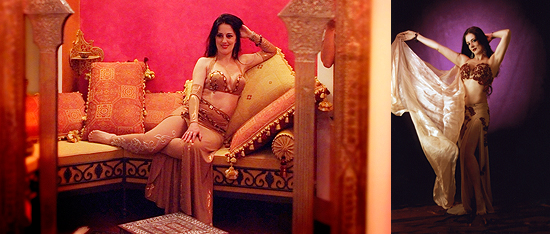
DANCE STYLES
VEIL DANCE
For centuries the veil has been an essential accessory of women's clothing. In pre-Islamic times in the Arabian Peninsula the women of high social class used to wear it. In ancient Greece, the veil was an attribute for the goddesses, for Homer, the ancient Greek poet, was a sign of femininity to every woman of any social status. The women also covered their hair to show their marital status: the veil was used as a sign of submission to her husband, to hide from the gaze of other men. Still today in the warmer regions of the Mediterranean and desert villages the women wrap themselves in veils, large enough to serve as a cloak which you can see only the eyes, this serves not only for social or religious reasons but also to resist the sand and high temperatures .
Literature, religion and philosophy have often used the veil as a metaphor. For Foscolo Minerva gave the veil to the Graces, goddesses of music, poetry and dance, which was used to protect them from human passions. The veil of Isis, the veil of Maya are metaphors of the truth behind the death of a female deity, custodian of the secrets of the human race.
The veil has a long history of everyday use; therefore it is difficult to think that it was only recently introduced as an element in oriental dance choreography. Some say that it was the first Samia Gamal to use the veil to enter a scene; and certainly it is due to her that we have an infinite variety of shapes and gestures that can be created with this tool of seduction.
The art of dance with the veil has been rediscovered and enhanced by numerous American dancers who have used it to create imaginative reinterpretations of the legendary "Dance of the Seven Veils" (remember the beautiful Rita Hayworth in the role of Salome).
DANCING WITH THE SWORD
Reminiscent of an ancient warrior dance practiced by men or a parody created by women in the harems between the playful and the rebels they were trying to seize the weapon of their "guardian" who groped for an improbable escape. The dance with a scimitar adds something mystical to the routine of a dancer. The scimitar is a real weapon and as such demands respect and attention in balancing. This type of dance requires a strong self-control and balance by the dancer, who must be very careful not to slide the sword down from the head or from the side on which it rests, while performing dance movements. All this while giving the impression to the public there is nothing to be concerned about the risk or danger, but imparting a sense of peace, balance and safety.
The effect is magic with a strong impact on the audience and on the psyche of the dancer; which seems strange to say, through this type of dance can almost reach a state of ecstatic meditation. Najma is known for this kind of performance and has practiced with respect and devotion since 1999, when she was "chosen" by his own sword as a dance fellow ... but that's another story.
DANCING WITH THE CANDLEABRA OR CANDLESTICK (RAQS EL Shaam-DAN)
Dance with the candleabra or the "tray with candles," in its earliest version, is reminiscent of an ancient ritual dance. The light of the candles represents the light of the sun and of the luminaries of the firmament and as such was connected to the rites dedicated to Ra (the sun god). Historically at the Mediterranean latitudes, but even more in the Nordic countries, this evocative dance was used to "strengthen the sun" in its ascent from winter to summer solstice. More recently, during the Islamic period, we find it at parties for the "coming forth" of a child.
Even today in Sweden we meet the candles for the feast of Saint Lucia, perhaps reminiscent of an ancient Celtic ritual. Many years ago, King Canute of Sweden declared that Christmas would last a month, from December 13th - at that time the solstice day of Winter – till January 13th , the day of St. Canute precisely. It is unknown why Lucia, a Sicilian saint of the fourth century, was so honored in the cold and distant Sweden: it is said that she had personally visited the country or that Christian missionaries preached about her to the people and to spread the cult. Whatever its origin, the Swedes showed much love for St. Lucy, '''the one who brings light”, celebrated on the day of the return of the sun and life.
Then in 1927 a Stockholm newspaper decided to hold a competition to elect the so-called ''Lucia of Sweden " which, with a crown of seven candles and dressed in a white robe, would have collected the offerings and gifts to distribute to the poor and needy people during the Christmas holidays. The initiative was a resounding success that persists today, so much so that, in Stockholm, she has been chosen to crown the winner of the Nobel Prize for Literature. Since 1950 the festival in Sweden is linked to the Sicilian so that the Swedish Lucia went to Syracuse, Italy to participate in the processions that concludes the festivities in honor of St. Lucy. From north to south, this dance of candles seems to have a common connection with the rites related to the rebirth of light.
More recently, the dance with candles, has been organized as a secret language of love. In Arab society, it is not permissible for a woman to explicitly declare her love, during a party if a woman grabs the candelabra and begins to dance with it on her head to say to her beloved: I long for love as a candle.
DANCING WITH STICK (RAQS EL Assaya)
Although the dance with the stick is a typically male dance, too, like the one with the scimitar, reminiscent of an ancient martial arts dance, the woman, in a sort of parody of the male dancing, uses this accessory in the hand and rotate it accompanying movements of the torso or hips with it. The rhythm used is that of Upper Egypt, the Saaid, the dress worn is usually a long tunic of heavy cotton canvas for men (gallabija), for the woman it is interwoven with golden threads and sequins.
DANCING WITH THE ZAGAT
Along with the castanets in flamenco and Andalusian dances oriental dance uses rhythm instruments.The Zagats or cymbals are usually made of copper or other metals, which is connected to two fingers of the dancer. It requires a perfect coordination between the sound of cymbals and the rhythmic movements of dance as well as a sound knowledge of Arabic rhythms by the dancer.
SHOWS
Oriental dance is an art form therefore Najma doesn’t perform in restaurants where belly dancing is an interlude between one plate and the other, but she has often been a guest at some ethnic clubs that promote Arab culture (Taus-Marino Club in Rome , Mythos in Chieti; Moresca in Bari, etc..) and at private parties and charity galas such as,Club Citizen of Ascoli Piceno, Ascoli Lions Club, Inner Wheel in San Benedetto del Tronto, the Red Cross of San Benedetto del Tronto, Guardia di Finanza, etc.. Najma continues to participate in important exhibitions and historical re-enactments alone or with her group.
For 2003 include:
June 06
Palacongressi S. Benedetto del Tronto, in the evening of the First Regional Conference of Immigration;
July 19
Rocca di Acquaviva, Italy at the National Meeting for 100 years Harley-Davidson (2003 URPIG Award as the best cultural event of the Piceno);
July 20
Spinetoli Folklore Festival organized by the Province of Ascoli Piceno, Italy;
July 21
"Towards the South" to the Castle of Falconara High Court;
August 09
Castorano, Ascoli Piceno Italy Review in the "Scena Picena";
September 25-27
Acquaviva, Piceno, and Ascoli Offida in three evenings devoted to "The City of History", 1 st International Festival of Living History.
December 21
"Light of the East" ex-church of St. Andrea Ascoli Piceno
For 2004:
March 26-28
"El Samar" at St. TeatrLaboratoriumAikot27 Benedetto del Tronto.
Najma with her Cultural Association is also committed to multi-ethnic integration, therefore, in collaboration with the President of the Council for the immigration of S. Benedetto del Tronto, Zouhair Ben Hammed, July 13th 2003 performed a show with the Ramses group dedicated to Saharawi children guests of the city on October 4th, then the laboratory?? has participated as a teacher of oriental dance with the children in the event "A square-color World Vibrations" held at the town of Grottammare. Ascoli Piceno, Italy.
Najma is finally facing the international scene, participating in the show with twenty of her best students at the opening of the Baglioni Tour 2003, June 14th at the Stadio del Conero in Ancona, Italy a show directed by Pepi Morgia, after passing a tough competition among more than 3,500 artists.
Najma also appears?? in the video-clip "I adore you" by Luciano Pavarotti, shot at Bonci Theatre in Cesena, Italy under the direction of choreographer Luca Tommassini.
Najma has numerous television appearances on local TV and national (TVRS, Quintarete, RAI 3, RAI 1). She appeared in the October 12th, 2003 prime time show "... I'll be back Saturday and three" conducted by Giorgio Panariello with his group of students at the birthday party for Luciano Pavarotti.

